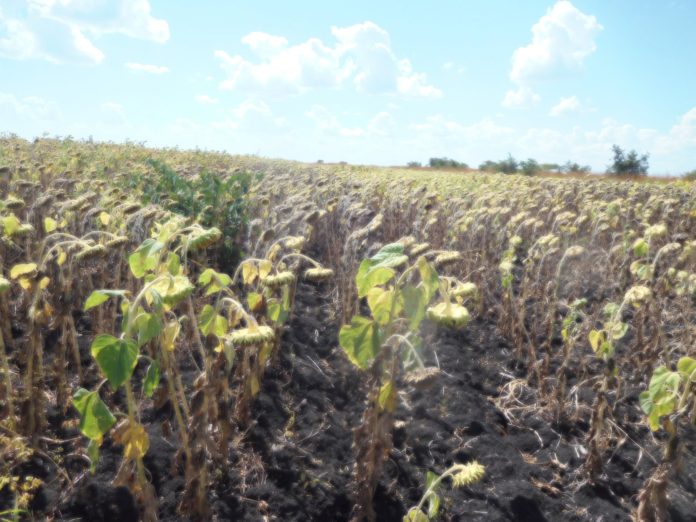“Many South African grain farmers often view sunflower as a second-fiddle crop, instead of the star of their grain-production enterprise. As a result, they tend not to dedicate enough time, attention and resources to it,” says Muntingh Hamman, Syngenta Campaign Lead for Row Crops. “Sunflower can, however, be much more than a catch crop. For one thing, it is well adapted to cope with dryer conditions. This advantage, combined with lower input costs, reliable market prices and the option to negotiate a premium based on oil content, allows sunflower to compete on equal footing with other grain crops.”
Sunflower’s ability to adapt to different climate conditions is ascribed to its tolerance for high and low temperatures alike. The crop’s capacity to deal with drought conditions can be a great advantage in the upcoming season, given predictions that El Niño is likely to cause below-average rainfall.
The tragedy of the war in Ukraine initially saw sunflower prices skyrocket, given that country’s status as one of the world’s biggest producers and exporters of sunflower (the other sunflower heavyweight is Russia). Agriculture in that region has since stabilised somewhat and by mid-October this year, sunflower grain traded at around R9 000/ton. While that is considerably lower than the R12 000/ton turning point, the price remains strong enough for sunflower to be an attractive alternative to soybeans. The latter is usually the preferred crop, but the market-price differential is currently fairly small.
Hamman points out that the market-price differential should be weighed against sunflower’s lower input costs and especially its potential to be the solution to grain production under dryer conditions. “The biggest source of untapped potential, however, is the premium that growers can earn for sunflower grain with a high oil content.”
Globally, Syngenta is regarded as the leader in sunflower genetics and now, following the amalgamation of Syngenta en Sensako, growers have direct access to top sunflower genetics under the Sensako brand. This offers growers the benefit of cultivars with a high oil content and herbicide tolerance.
SY 3970 CL and SNK 270 CL are two of the Syngenta sunflower cultivars that can be planted specifically with a view to deliver high oil content. “The future of sunflower lies in oil,” says Charles Basson, Sunflower Breeder and Product Placement Lead at Syngenta. “In the past, the focus used to be on grain yield only, leaving processors with the short end of the stick. The new focus is on cultvars with a high oil content, which can contribute to better profitability for growers and processors alike.”
The current oil-content standard for sunflower grain is between 36% and 38%, but with SY 3970 CL growers have been achieving 42% to 50% oil in the past few years. “There are several new cultivars in the Syngenta pipeline and growers can look forward to products that will not only yield high oil content but will also perform very well in terms of grain yield,” says Basson.
With the right support and planning, which includes crop protection, growers can realise excellent returns on an investment in sunflower.
“Syngenta offers a comprehensive crop-protection package for sunflower and that, in combination with our superior cultivars and high-quality seed, gives growers just about everything they need to make the most of a sunflower planting,” says Hamman.
Sunflower is traditionally grown in the western parts of the summer grain production region but can be planted just as successfully in other production areas. “It is understandable that some growers prefer to plant soybeans because yields are usually higher. However, with METAGAN® Gold to control grasses and suppress sedges pre emergence, and CAPTORA® to control broadleaves and certain grass weeds post emergence, it is possible to limit weed competition to a large extent and effectively protect sunflower seedlings,” says Hamman.
Later in the season, the likes of AMISTAR® and AMPLIGO® will control and even prevent fungal infections and insect damage respectively. Foliar feeding at the right time will furthermore make a significantly positive difference.
“A holistic approach will safeguard a sunflower crop and allow growers to maximise yield and profit,” says Hamman. Such an approach includes crop rotation, specifically to combat Sclerotinia sclerotiorum, the fungus that causes stem rot. It is also important to plant sunflower at the right time. Although growers often joke that sunflower can be planted up to 35 January when the maize season runs late, November is the best time to get seeds in the soil. By simply planting earlier, growers can ensure higher sunflower yields and better profit margins.
Growers aiming for optimal yield and oil content cannot continue treating sunflower as a catch crop. “Sunflower requires the same careful management and cultivation practices as other crops. It is possible to make good money with the yellow flowers, provided you adhere to the optimal plant window, fertilise properly and implement solid management practices,” concludes Hamman.









